Chronology
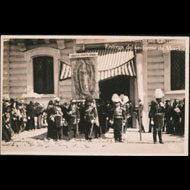 |
|
1810
On September 16 Miguel Hidalgo y Castilla, a parish priest, issues the "Grito
de Dolores," calling for the end of Spanish rule, equality among races,
and land redistribution. The date is now celebrated as Mexican Independence Day.
1821
On August 24 Mexico gains its independence from Spain after 11 years of
war.
1824 Mexico adopts a republican constitution and the Republic of Mexico succeeds the short-lived Mexican Empire.
1846–1848 The United States and Mexico go to war over the U.S. annexation of Texas and other grievances. The U.S. invades Mexico, and on April 18, 1847, General Winfield Scott captures Mexico City. On February 2, 1848, the Treaty of Guadalupe Hidalgo cedes all territory north of the Rio Grand and Gila River to the U.S. for $15 million.
1847 Mayan peasants rise up against Yucatecan authorities beginning a long period of rebellion known as the Caste War.
1854 A liberal revolution ends the dictatorship of President Antonio López de Santa Anna, who is forced into exile. Benito Juárez returns from exile in Louisiana and becomes Minister of Justice.
1857 A new constitution is approved which reduces the power of the army and the Catholic Church and increases the power of the central executive. This constitution remains in effect until 1917.
1857–1860 Led by General Miguel Miramón, the conservative Mexican army rebels against the liberal government in a three-year civil war during which time the army temporarily gains control over most of the country, with Miramón becoming president. His government is eventually routed by Benito Juárez's liberal troops.
1824 Mexico adopts a republican constitution and the Republic of Mexico succeeds the short-lived Mexican Empire.
1846–1848 The United States and Mexico go to war over the U.S. annexation of Texas and other grievances. The U.S. invades Mexico, and on April 18, 1847, General Winfield Scott captures Mexico City. On February 2, 1848, the Treaty of Guadalupe Hidalgo cedes all territory north of the Rio Grand and Gila River to the U.S. for $15 million.
1847 Mayan peasants rise up against Yucatecan authorities beginning a long period of rebellion known as the Caste War.
1854 A liberal revolution ends the dictatorship of President Antonio López de Santa Anna, who is forced into exile. Benito Juárez returns from exile in Louisiana and becomes Minister of Justice.
1857 A new constitution is approved which reduces the power of the army and the Catholic Church and increases the power of the central executive. This constitution remains in effect until 1917.
1857–1860 Led by General Miguel Miramón, the conservative Mexican army rebels against the liberal government in a three-year civil war during which time the army temporarily gains control over most of the country, with Miramón becoming president. His government is eventually routed by Benito Juárez's liberal troops.
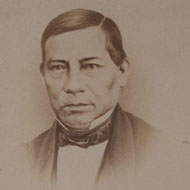 |
|
1861 Benito Juárez is elected president. European creditors demand repayment
of debts incurred by the previous regime and send a punitive force to Mexico.
Although the Spanish and English forces soon withdraw, Napoleon III of France
sees Mexico as a base from which to advance his idea for a Latin league that
would include the former New World possessions of Spain and Portugal as well
as parts of the Mediterranean.
1862
On May 5 the French troops are defeated by the Mexican army in the Battle
of Puebla, now commemorated as Cinco de Mayo.
1863 General Forey captures Puebla in March and on June 10 the French army makes its triumphal entry into Mexico City.
1863 General Forey captures Puebla in March and on June 10 the French army makes its triumphal entry into Mexico City.
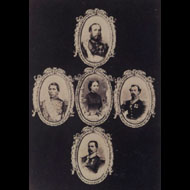 |
|
1864
Nominated by Napoleon III and supported by the French army, the
Hapsburg Archduke Maximilian and his wife Carlota, daughter of Leopold I, are
crowned Emperor and Empress of Mexico on June 12.
1865
The United States demands the withdrawal of French troops, claiming that
their presence is a violation of the Monroe Doctrine.
1866 Napoleon III begins evacuating the French forces from Mexico. Carlota journeys to Europe to seek support for Maximilian. She never returns to Mexico.
1866 Napoleon III begins evacuating the French forces from Mexico. Carlota journeys to Europe to seek support for Maximilian. She never returns to Mexico.
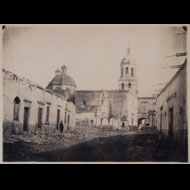 |
|
1867
French troops are completely withdrawn by early March. Maximilian retreats
to Querétaro with his Imperial Mexican Army, where he is besieged by Benito
Juárez's troops. Maximilian is captured on May 15, tried, and then
executed along with generals Miguel Miramón and Tomás Mejía
on June 19. Juárez reenters Mexico City on July 15 and resumes the presidency
in December. Under Juárez, Mexico begins the process of modernization by
expanding the transportation and communications systems and exploiting natural
resources.
1873
On July 18 Benito Juárez dies suddenly and a day later Sebastián
Lerdo de Tejada succeeds him as provisional president. Tejada continues to follow
Juárez's social reform and economic expansion programs.
1876 After leading a successful coup d'état during the presidential election, General Porfirio Díaz assumes the presidency in November, beginning the period known as the Porfiriato.
1880 Porfirio Díaz's political ally, General Manuel González assumes the presidency. During González's administration Díaz consolidates power and builds a strong political machine.
1876 After leading a successful coup d'état during the presidential election, General Porfirio Díaz assumes the presidency in November, beginning the period known as the Porfiriato.
1880 Porfirio Díaz's political ally, General Manuel González assumes the presidency. During González's administration Díaz consolidates power and builds a strong political machine.
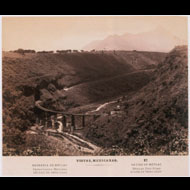 |
|
1884
Porfirio Díaz is reelected president, and holds the office until
1911. He relies heavily on foreign investment in order to bolster the debt-ridden
government, and also promotes wide-ranging social, economic, and technological
changes. However, modernization, land reform, and the introduction of the railway
system through arable land also disenfranchise traditional rural communities,
when many Mexican peasants are unable to prove legal title to the land they have
worked for generations. By 1910 over half of the rural population will be living
and working on the newly formed haciendas.
1908
In response to growing sentiment against his increasingly repressive regime
Díaz states in an interview that it is time for Mexico to move towards
democracy. He declares he will support an opposition party in the 1910 election,
and in so doing gives the impression that he is ready to step down from the presidency.
Opposition groups begin to plan their campaigns.
1909 Díaz announces that he will run for reelection after all. Francisco Madero emerges as the candidate of the opposing Anti-reelctionist Party.
1909 Díaz announces that he will run for reelection after all. Francisco Madero emerges as the candidate of the opposing Anti-reelctionist Party.
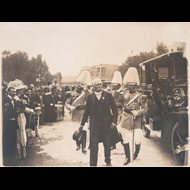 |
|
1910
Porfirio Díaz presides over elaborate centennial celebrations designed
to glorify the Porfiriato's modernization of Mexico and display the country's
progress before the eyes of the world. On the eve of the June election Madero
is arrested for sedition and imprisoned, and Diáz takes the election.
In October Madero publishes the Plan of San Luis Potosí, declaring himself
the legitimate president of Mexico. He calls unsuccessfully for a countrywide
insurrection to begin on November 20, the date now considered the start of the
Mexican Revolution.
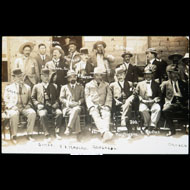 |
|
1911
Francisco Madero joins forces with Pascual Orozco, Pancho Villa, and Emiliano
Zapata, whose bands of rebels had been skirmishing with federal troops. Simultaneous
uprisings around the country, culminating in the capture of Ciudad Juárez
on May 10, force Díaz to relinquish the presidency. That fall Madero is
elected president. Emiliano Zapata, ardent champion of Indian and peasant rights,
adopts "Tierra y Libertad" (Land and Liberty) as his slogan. His Plan of Ayala calls for the repossession of all land usurped by the
large landowners.
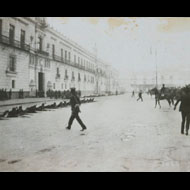 |
|
1913
In February a series of counterrevolutionary revolts against Madero's
government culminates in ten days of bloody fighting (the "Decena Trágica")
in Mexico City between conservative rebel forces and federal troops under the
command of General Victoriano Huerta. The fighting ends when Huerta conspires
with his former adversaries Bernardo Reyes and Félix Díaz to betray
Francisco Madero. Huerta declares himself president and orders the assassinations
of Madero and his vice president José María Pino Suárez,
whom he had arrested a few days earlier.
1913–14
Venustiano Carranza, the governor of Coahuila, leads a revolt against
Victoriano Huerta in the name of returning Mexico to constitutionalist rule and
soon controls one-third of the country.
1914 United States President Woodrow Wilson refuses to recognize Victoriano Huerta's authority and supplies Venustiano Carranza with arms. Huerta's troops detain the crew of the U.S.S. Dolphin, anchored in the port of Tampico, causing U.S. armed forces to invade Veracruz and occupy the city for six months. Huerta's lack of munitions positions Carranza's constitutionalist army to gain control of the government. In June Carranza and Pancho Villa join forces, march on Mexico City, and force Huerta into exile. They enter Mexico City as leaders of the revolution, but by October the revolutionary factions split, and Villa and Zapata flee the capitol in December.
1914 United States President Woodrow Wilson refuses to recognize Victoriano Huerta's authority and supplies Venustiano Carranza with arms. Huerta's troops detain the crew of the U.S.S. Dolphin, anchored in the port of Tampico, causing U.S. armed forces to invade Veracruz and occupy the city for six months. Huerta's lack of munitions positions Carranza's constitutionalist army to gain control of the government. In June Carranza and Pancho Villa join forces, march on Mexico City, and force Huerta into exile. They enter Mexico City as leaders of the revolution, but by October the revolutionary factions split, and Villa and Zapata flee the capitol in December.
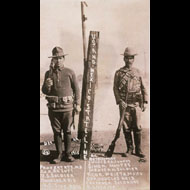 |
|
1915
Carranza becomes provisional president after General Álvaro Obregón
defeats Pancho Villa's División del Norte at Celaya. Intense fighting
between Villa's troops and the U.S. army begins along the Mexican-U.S.
borderlands and continues for the next five years, as does the fighting.
1916
On March 9 Pancho Villa raids Columbus, New Mexico, in retaliation against
the United States' support of Carranza.
1917 A new constitution is adopted that incorporates the concerns of the various revolutionary factions, such as land reform, civil liberties, and national ownership of natural resources. Venustiano Carranza is elected president.
1919 On April 10 Emiliano Zapata is ambushed and murdered by Carranza's troops. Looting and indiscriminate violence continue throughout the countryside.
1920 Álvaro Obregón leads an armed rebellion against Venustiano Carranza when he tries to name a moderate successor to the presidency. Carranza is murdered as he flees Mexico City. Obregón is elected president, negotiates peace between the remaining revolutionary factions, and initiates a series of beneficial reforms, including sanctioning labor and peasant organizations.
1917 A new constitution is adopted that incorporates the concerns of the various revolutionary factions, such as land reform, civil liberties, and national ownership of natural resources. Venustiano Carranza is elected president.
1919 On April 10 Emiliano Zapata is ambushed and murdered by Carranza's troops. Looting and indiscriminate violence continue throughout the countryside.
1920 Álvaro Obregón leads an armed rebellion against Venustiano Carranza when he tries to name a moderate successor to the presidency. Carranza is murdered as he flees Mexico City. Obregón is elected president, negotiates peace between the remaining revolutionary factions, and initiates a series of beneficial reforms, including sanctioning labor and peasant organizations.
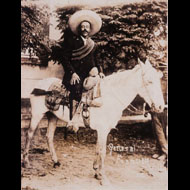 |
|
1923
Francisco (Pancho) Villa is assassinated three years after retiring to his ranch near
Parral, Chihuahua.